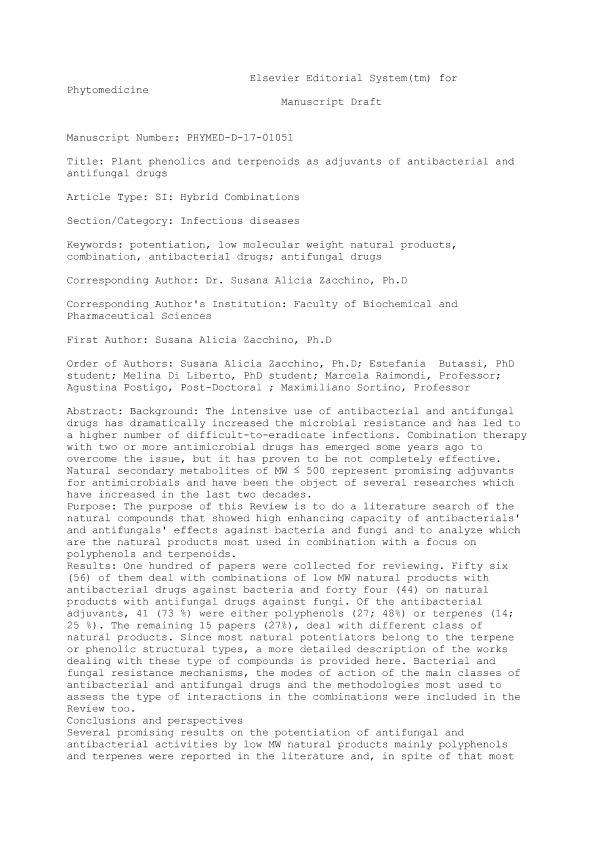Mostrar el registro sencillo del ítem
dc.contributor.author
Zacchino, Susana Alicia Stella

dc.contributor.author
Butassi, Estefanía

dc.contributor.author
Di Liberto, Melina Gabriela

dc.contributor.author
Raimondi, Marcela
dc.contributor.author
Postigo, Agustina

dc.contributor.author
Sortino, Maximiliano Andrés

dc.date.available
2018-06-28T19:01:34Z
dc.date.issued
2017-12
dc.identifier.citation
Zacchino, Susana Alicia Stella; Butassi, Estefanía; Di Liberto, Melina Gabriela; Raimondi, Marcela; Postigo, Agustina; et al.; Plant phenolics and terpenoids as adjuvants of antibacterial and antifungal drugs; Elsevier Gmbh; Phytomedicine; 37; 12-2017; 27-48
dc.identifier.issn
0944-7113
dc.identifier.uri
http://hdl.handle.net/11336/50463
dc.description.abstract
Background The intensive use of antibacterial and antifungal drugs has dramatically increased the microbial resistance and has led to a higher number of difficult-to-eradicate infections. Combination therapy with two or more antimicrobial drugs has emerged some years ago to overcome the issue, but it has proven to be not completely effective. Natural secondary metabolites of MW ≤ 500 represent promising adjuvants for antimicrobials and have been the object of several researches that have increased in the last two decades. Purpose The purpose of this Review is to do a literature search of the natural compounds that showed high enhancing capacity of antibacterials’ and antifungals’ effects against planktonic bacteria and fungi and to analyze which are the natural products most used in combination with a focus on polyphenols and terpenoids. Results One hundred of papers were collected for reviewing. Fifty six (56) of them deal with combinations of low MW natural products with antibacterial drugs against planktonic bacteria and forty four (44) on natural products with antifungal drugs against planktonic fungi. Of the antibacterial adjuvants, 41 (73%) were either polyphenols (27; 48%) or terpenes (14; 25%). The remaining 15 papers (27%), deal with different class of natural products. Since most natural potentiators belong to the terpene or phenolic structural types, a more detailed description of the works dealing with these type of compounds is provided here. Bacterial and fungal resistance mechanisms, the modes of action of the main classes of antibacterial and antifungal drugs and the methodologies most used to assess the type of interactions in the combinations were included in the Review too. Conclusions and perspectives Several promising results on the potentiation effects of antifungals’ and antibacterials’ activities by low MW natural products mainly on polyphenols and terpenes were reported in the literature and, in spite of that most works included only in vitro assays, this knowledge opens a wide range of possibilities for the combination antimicrobial therapy. Further research including in vivo assays and clinical trials are required to determine the relevance of these antimicrobial enhancers in the clinical area and should be the focus of future studies in order to develop new antimicrobial combination agents that overpass the drawbacks of the existing antibiotics and antifungals in clinical use.
dc.format
application/pdf
dc.language.iso
eng
dc.publisher
Elsevier Gmbh

dc.rights
info:eu-repo/semantics/openAccess
dc.rights.uri
https://creativecommons.org/licenses/by-nc-sa/2.5/ar/
dc.subject
Antifungal Drugs
dc.subject
Combination, Antibacterial Drugs
dc.subject
Low Molecular Weight Natural Products
dc.subject
Potentiation
dc.subject.classification
Otras Ciencias Químicas

dc.subject.classification
Ciencias Químicas

dc.subject.classification
CIENCIAS NATURALES Y EXACTAS

dc.title
Plant phenolics and terpenoids as adjuvants of antibacterial and antifungal drugs
dc.type
info:eu-repo/semantics/article
dc.type
info:ar-repo/semantics/artículo
dc.type
info:eu-repo/semantics/publishedVersion
dc.date.updated
2018-06-28T14:08:49Z
dc.journal.volume
37
dc.journal.pagination
27-48
dc.journal.pais
Alemania

dc.journal.ciudad
Stuttgart
dc.description.fil
Fil: Zacchino, Susana Alicia Stella. Universidad Nacional de Rosario. Facultad de Ciencias Bioquímicas y Farmacéuticas. Departamento de Química Orgánica. Área Farmacognosia; Argentina
dc.description.fil
Fil: Butassi, Estefanía. Universidad Nacional de Rosario. Facultad de Ciencias Bioquímicas y Farmacéuticas. Departamento de Química Orgánica. Área Farmacognosia; Argentina
dc.description.fil
Fil: Di Liberto, Melina Gabriela. Universidad Nacional de Rosario. Facultad de Ciencias Bioquímicas y Farmacéuticas. Departamento de Química Orgánica. Área Farmacognosia; Argentina
dc.description.fil
Fil: Raimondi, Marcela. Universidad Nacional de Rosario. Facultad de Ciencias Médicas; Argentina
dc.description.fil
Fil: Postigo, Agustina. Universidad Nacional de Rosario. Facultad de Ciencias Bioquímicas y Farmacéuticas. Departamento de Química Orgánica. Área Farmacognosia; Argentina
dc.description.fil
Fil: Sortino, Maximiliano Andrés. Universidad Nacional de Rosario. Facultad de Ciencias Bioquímicas y Farmacéuticas. Departamento de Química Orgánica. Área Farmacognosia; Argentina. Universidad Nacional de Rosario. Facultad de Ciencias Bioquímicas y Farmacéuticas. Área Micología; Argentina
dc.journal.title
Phytomedicine

dc.relation.alternativeid
info:eu-repo/semantics/altIdentifier/doi/https://dx.doi.org/10.1016/j.phymed.2017.10.018
dc.relation.alternativeid
info:eu-repo/semantics/altIdentifier/url/https://www.sciencedirect.com/science/article/pii/S0944711317301605
Archivos asociados
